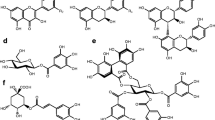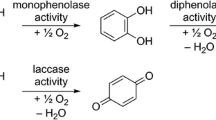Summary
Much more tannic acid or pin oak tannin is required to precipitate the abundant leaf protein, ribulose-1,5-bisphosphate carboxylase/oxygenase (RuBPC), from Manduca sexta gut fluid adjusted to pH 6.5 than is required to precipitate this protein from an aqueous buffer at the same pH. This finding demonstrates that some characteristic of M. sexta gut fluid, in addition to its basicity, counteracts the potential of tannins to precipitate ingested proteins. Gut fluid of M. sexta has a surface tension of 36–39 dynes/cm, indicating the presence of surfactants. Lysolecithin and linoleoylglycine, surfactants known to be present in insect gut fluids, also interfere with the precipitation of RuBPC by tannins at pH 6.5. It is concluded that detergency is a widespread property of insect gut fluids that counteracts the potential of tannins to precipitate die ary proteins, and it is argued that there is no longer any justification for continuing to refer to tannins as digestibility-reducing-substances. Finding that there has been no formidable barrier to the evolution of mechanisms that counter a generalized antidigestive action by tannins is difficult to reconcile with the idea that reduced digestibility is an evolved anti-herbivore adaptation of apparent plants.
Similar content being viewed by others
References
Akazawa T (1970) The structure and function of fraction-I protein. Progr Phytochem 2:107–141
Berenbaum M (1980) Adaptive significance of midgut pH in larval Lepidoptera. Am Nat 115:138–146
Bernays EA (1981) Plant tannins and insect herbivores: an appraisal. Ecol Entomol 6:353–360
Bernays EA, Chamberlain DJ (1980) A study of tolerance of ingested tannin in Schistocerca gregaria. J Insect Physiol 26:415–420
Bernays EA, Chamberlain DJ, McCarthy P (1980) The differential effects of ingested tannic acid on different species of Acridoidea. Entomol Exp Appl 28:158–166
Bernays EA, Chamberlain DJ, Leather EM (1981) Tolerance of acridids to ingested condensed tannins. J Chem Ecol 7:247–256
Bradford M (1976) A rapid and sensitive method for the quantitation of microgram quantities of protein utilizing the principle of protein-dye binding. Anal Biochem 72:248–254
Collatz KG, Mommsen T (1974) Die Struktur der emulgierenden Substanzen verschiedener Invertebraten. J Comp Physiol 94:339–352
Feeny PP (1970) Seasonal changes in oak leaf tannins and nutrients as a cause of spring feeding by winter moth caterpillars. Ecology 51:565–581
Feeny P (1976) Plant apparency and chemical defense. Rec Adv Phytochem 10:1–40
Ferguson A (1943) Surface tension and its measurement. Endeavor 2:34–38
Foo LY, Porter LJ (1980) The phytochemistry of proanthocyanidin polymers. Phytochemistry 19:1747–1754
Goldstein JL, Swain T (1965) The inhibition of enzymes by tannins. Phytochemistry 4:185–192
Hagerman AE, Butler LG (1978) Protein precipitation method for the quantitative determination of tannins. J Agric Food Chem 26:809–812
Hagerman AE, Butler LG (1981) The specificity of proanthocyanidin-protein interactions. J Biol Chem 256:4494–4497
Jensen RG, Bahr JT (1977) Ribulose-1,5-bisphosphate carboxylase-oxygenase. Ann Rev Plant Physiol 28:379–400
Klocke JA, Chan BG (1982) Effects of cotton-condensed tannin on feeding and digestion in the cotton pest, Heliothis zea. J Insect Physiol 28:911–915
Lyttleton JW (1973) Proteins and nucleic acids. Chem Biochem Herb 1:63–103
Martin JS, Martin MM (1983) Tannin assays in ecological studies. Precipitation of ribulose-1,5-bisphosphate carboxylase/oxygenase by tannic acid, quebracho, and oak foliage extracts. J Chem Ecol 9:285–294
McManus J, Lilley TH, Haslam E (1983) Plant polyphenols and their association with proteins. In: Hedin PA (ed) Plant resistance to insects. ACS Symposium Series 208. American Chemical Society, Washington, D.C., pp 123–137
Oh HI, Hoff JE, Armstrong GS, Haff LA (1980) Hydrophobic interaction in tannin-protein complexes. J Agric Food Chem 28:394–398
Reese JC, Chan BG, Waiss Jr AC (1982) Effects of cotton condensed tannin, maysin (corn) and pinitol (soybeans) on Heliothis zea growth and development. J Chem Ecol 8:1429–1436
Rhoades DF, Cates RG (1976) A general theory of plant antiherbivore chemistry. Rec Adv Phytochem 10:168–213
Singer EJ, Eggman L, Campbell JM, Wildman SG (1952) The proteins of green leaves. IV. A high molecular weight protein comprising a large part of the cytoplasmic protein. J Biol Chem 197:233–239
Swain T (1979) Tannins and lignins. In: Rosenthal GA, Janzen DH (eds) Herbivores: their interaction with secondary plant metabolites. Academic Press, New York, pp 657–682
Tsuchiki Y, Suzuki Y, Kobayashi A, Saito C (1965) Acylated amino acids. Japanese Patent 10,571. Chemical Abstracts 63:5740b (1965)
Turunen S, Kastari T (1979) Digestion and absorption of lecithin in larvae of the cabbage butterfly, Pieris brassicae. Comp Biochem Physiol 62A:933–937
Van Sumere CF, Albrecht J, Dedonder A, de Pooter H, Pe I (1975) Plant protein and phenolics. In: Harborne JB, Van Sumere CF (eds) The chemistry and biochemistry of plant proteins. Academic Press, New York, pp 211–264
Vonk HJ (1969) The properties of some emulsifiers in the digestive fluids of invertebrates. Comp Biochem Physiol 29:361–371
Yamamoto RT (1969) Mass rearing of the tobacco hornworm. II. Larval rearing and preparation. J Econ Entomol 62:1427–1431
Author information
Authors and Affiliations
Rights and permissions
About this article
Cite this article
Martin, M.M., Martin, J.S. Surfactants: their role in preventing the precipitation of proteins by tannins in insect guts. Oecologia 61, 342–345 (1984). https://doi.org/10.1007/BF00379632
Received:
Issue Date:
DOI: https://doi.org/10.1007/BF00379632




